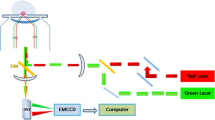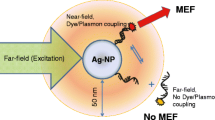Abstract
In this study, we propose a microchip that is sequentially capable of fluorescently staining and washing DNAs. The main advantage of this microchip is that it allows for one-step preparation of small amounts of solution without degrading microscopic bio-objects such as the DNAs, cells, and biomolecules to be stained. The microchip consists of two inlets, the main channel, staining zone, washing zone, and one outlet, and was processed using a femtosecond laser system. High molecular transport of rhodamine B to deionized water was observed in the performance test of the microchip. Results revealed that the one-step procedure of on-chip DNA staining and washing was excellent compared to the conventional staining method. The one-step preparation of stained and washed DNAs through the microchip will be useful for preparing small volumes of experimental samples.





Similar content being viewed by others
References
L. Schermelleh, R. Heintzmann, H. Leonhardt, A guide to super-resolution fluorescence microscopy. J. Cell Biol. 190, 165–175 (2010)
M. Gao, F. Yu, C. Lv, J. Choo, L. Chen, Fluorescent chemical probes for accurate tumor diagnosis and targeting therapy. Chem. Soc. Rev. 46, 2237–2271 (2017)
M. Ratz, I. Testa, S.W. Hell, S. Jakobs, Crispr/cas9-mediated endogenous protein tagging for resolft super-resolution microscopy of living human cells. Sci. Rep. 5, 9592 (2015)
F. Göttfert, T. Pleiner, J. Heine, V. Westphal, D. Görlich, S.J. Sahl, S.W. Hell, Strong signal increase in sted fluorescence microscopy by imaging regions of subdiffraction extent. Proc. Natl. Acad. Sci. U. S. A. 114, 2125–2130 (2017)
M. Pusey, J. Barcena, M. Morris, A. Singhal, Q. Yuan, J. Ng, Trace fluorescent labeling for protein crystallization. Acta Crystallogr. F Struct. Biol. Commun. 71, 806–814 (2015)
J.R. Simard, M. Getlik, C. Grütter, R. Schneider, S. Wulfert, D. Rauh, Fluorophore labeling of the glycine-rich loop as a method of identifying inhibitors that bind to active and inactive kinase conformations. J. Am. Chem. Soc. 132, 4152–4160 (2010)
T. Tamura, Y. Kioi, T. Miki, S. Tsukiji, I. Hamachi, Fluorophore labeling of native fkbp12 by ligand-directed tosyl chemistry allows detection of its molecular interactions in vitro and in living cells. J. Am. Chem. Soc. 135, 6782–6785 (2013)
K.E. Beatty, D.A. Tirrell, Two-color labeling of temporally defined protein populations in mammalian cells. Bioorg. Med. Chem. Lett. 18, 5995–5999 (2008)
A. Hartmann, G. Krainer, M. Schlierf, Different fluorophore labeling strategies and designs affect millisecond kinetics of DNA hairpins. Molecules 19, 13735–13754 (2014)
C.G. Jones, V. Stavila, M.A. Conroy, P. Feng, B.V. Slaughter, C.E. Ashley, M.D. Allendorf, Versatile synthesis and fluorescent labeling of zif-90 nanoparticles for biomedical applications. ACS Appl. Mater. Interfaces 8, 7623–7630 (2016)
H. Sahoo, Fluorescent labeling techniques in biomolecules: a flashback. RSC Adv. 2, 7017–7029 (2012)
W. Nomura, Y. Tanabe, H. Tsutsumi, T. Tanaka, K. Ohba, N. Yamamoto, H. Tamamura, Fluorophore labeling enables imaging and evaluation of specific cxcr4− ligand interaction at the cell membrane for fluorescence-based screening. Bioconjug. Chem. 19, 1917–1920 (2008)
Z. Li, K. Munro, I.I. Ebralize, M.R. Narouz, J.D. Padmos, H. Hao, C.M. Crudden, J.H. Horton, N-heterocyclic carbene self-assembled monolayers on gold as surface plasmon resonance biosensors. Langmuir 33, 13936–13944 (2017)
S. Savas, A. Ersoy, Y. Gulmez, S. Kilic, B. Levent, Z. Altintas, Nanoparticle enhanced antibody and DNA biosensors for sensitive detection of salmonella. Materials 11, 1541 (2018)
L. Huang, Z. Li, Y. Lou, F. Cao, D. Zhang, X. Li, Recent advances in scanning electrochemical microscopy for biological applications. Materials 11, 1389 (2018)
J.G. Egan, N. Drossis, I.I. Ebralidze, H.M. Fruehwald, N.O. Laschuk, J. Poisson, H.W. de Haan, O.V. Zenkina, Hemoglobin-driven iron-directed assembly of gold nanoparticles. RSC Adv. 8, 15675–15686 (2018)
M. Salerno, S. Dante, Scanning kelvin probe microscopy: challenges and perspectives towards increased application on biomaterials and biological samples. Materials 11, 951 (2018)
X. Ji, K. Ji, V. Chittavong, R.E. Aghoghovbia, M. Zhu, B. Wang, Click and fluoresce: a bioorthogonally activated smart probe for wash-free fluorescent labeling of biomolecules. J. Org. Chem. 82, 1471–1476 (2017)
H. Nonaka, S.-h. Fujishima, S.-h. Uchinomiya, A. Ojida, I. Hamachi, Selective covalent labeling of tag-fused gpcr proteins on live cell surface with a synthetic probe for their functional analysis. J. Am. Chem. Soc. 132, 9301–9309 (2010)
V.C. DeRocco, T. Anderson, J. Piehler, D.A. Erie, K. Weninger, Four-color single molecule fluorescence with noncovalent dye labeling to monitor dynamic multimolecular complexes. Biotechniques 49, 807 (2010)
M. Rashidian, J.K. Dozier, M.D. Distefano, Enzymatic labeling of proteins: techniques and approaches. Bioconjug. Chem. 24, 1277–1294 (2013)
M.Z. Lin, L. Wang, Selective labeling of proteins with chemical probes in living cells. Physiology 23, 131–141 (2008)
Y. Yano, N. Furukawa, S. Ono, Y. Takeda, K. Matsuzaki, Selective amine labeling of cell surface proteins guided by coiled-coil assembly. Biopolymers 106, 484–490 (2016)
L.A. Montoya, M.D. Pluth, Hydrogen sulfide deactivates common nitrobenzofurazan-based fluorescent thiol labeling reagents. Anal. Chem. 86, 6032–6039 (2014)
M.H. Lauer, C. Vranken, J. Deen, W. Frederickx, W. Vanderlinden, N. Wand, V. Leen, M.H. Gehlen, J. Hofkens, R.K. Neely, Methyltransferase-directed covalent coupling of fluorophores to DNA. Chem. Sci. 8, 3804–3811 (2017)
Y. Suseela, N. Narayanaswamy, S. Pratihar, T. Govindaraju, Far-red fluorescent probes for canonical and non-canonical nucleic acid structures: current progress and future implications. Chem. Soc. Rev. 47, 1098–1131 (2018)
M. Schürmann, G. Cojoc, S. Girardo, E. Ulbricht, J. Guck, P. Müller, Three-dimensional correlative single-cell imaging utilizing fluorescence and refractive index tomography. J. Biophotonics 11, e201700145 (2018)
E.A. Specht, E. Braselmann, A.E. Palmer, A critical and comparative review of fluorescent tools for live-cell imaging. Annu. Rev. Physiol. 79, 93–117 (2017)
K.M. Piltti, B.J. Cummings, K. Carta, A. Manughian-Peter, C.L. Worne, K. Singh, D. Ong, Y. Maksymyuk, M. Khine, A.J. Anderson, Live-cell time-lapse imaging and single-cell tracking of in vitro cultured neural stem cells–tools for analyzing dynamics of cell cycle, migration, and lineage selection. Methods 133, 81–90 (2018)
S. Claveau, J.-R. Bertrand, F. Treussart, Fluorescent nanodiamond applications for cellular process sensing and cell tracking. Micromachines 9, 247 (2018)
N. Futai, M. Tamura, T. Ogawa, M. Tanaka, Microfluidic long-term gradient generator with axon separation prototyped by 185 nm diffused light photolithography of su-8 photoresist. Micromachines 10, 9 (2019)
M. Gallab, K. Tomita, S. Omata, F. Arai, Fabrication of 3d capillary vessel models with circulatory connection ports. Micromachines 9, 101 (2018)
Acknowledgments
This work was supported by the National Research Foundation of Korea (NRF) funded by the Ministry of Science and ICT (2017R1A4A1015681, NRF-2018R1D1A3B07047434, and 2019R1I1A3A01060695).
Author information
Authors and Affiliations
Contributions
Conceptualization, Jinmu Jung and Jonghyun Oh; Data curation, Yeongseok Jang and Hojun Shin; Formal analysis, Yeongseok Jang and Hojun Shin; Investigation, Yeongseok Jang and Hojun Shin; Project administration, Jinmu Jung and Jonghyun Oh; Supervision, Jinmu Jung and Jonghyun Oh; Writing—original draft, Yeongseok Jang and Hojun Shin; Writing—review & editing, Jinmu Jung and Jonghyun Oh.
Corresponding authors
Ethics declarations
Conflict of interest
The authors declare no conflict of interest.
Additional information
Publisher’s note
Springer Nature remains neutral with regard to jurisdictional claims in published maps and institutional affiliations.
Rights and permissions
About this article
Cite this article
Jang, Y., Shin, H., Jung, J. et al. One-step microchip for DNA fluorescent labeling. Biomed Microdevices 22, 1 (2020). https://doi.org/10.1007/s10544-019-0454-1
Published:
DOI: https://doi.org/10.1007/s10544-019-0454-1




